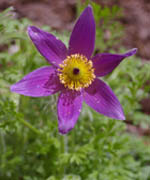|
 Pulsatilla Vulgaris (Pasque Flower) Pulsatilla Vulgaris (Pasque Flower)
Scientific Name(s):
Pulsatilla vulgaris Mill. P. pratensis L., P. patens (L.) Mill. Family:
Ranunculaceae (buttercup family)
Common Name(s): Pasque
flower , meadow anemone , pulsatilla , wind flower , Easter flower
Commonly called the pasque flower, this eye-catching perennial is the
state flower of South Dakota, where it grows wild. It has feathery
foliage and purple, maroon or white flowers. Long hairs cover the blooms
and resulting seedheads, which give the flowers a fuzzy appearance
This flower grows to between 6 and 12 inches high and produces a
bell-shaped purple to blue blossom with a yellow center. It prefers
sparsely wooded coniferous forests and meadows with soils rich in
calcium. After flowering, it produces a fuzzy, round fruit. Pulsatilla
vulgaris has finely divided, fernlike leaves.
Health Benefits
The dried whole plant of pulsatilla has been used in Europe for a
variety of medicinal purposes, including dysmenorrhea and other
gynecological disorders, skin diseases, asthma, and eye infections, and
as a diuretic and expectorant. It is widely used in homeopathic
preparations, once being considered specific for measles, and also used
for toothache, earache, and indigestion. A large number of Asian species
of pulsatilla (eg, P. cernua Spreng ., Japanese name “Hakutoo,” P.
chinensis (Bunge) Regel. and others, Chinese name “Bai Tou Weng”) have
also been used medicinally.
The most notable compounds in pulsatilla and many other Ranunculaceae
are ranunculin, protoanemonin, and anemonin. Protoanemonin has been
reported to have antibacterial, antimalarial, and antifungal activity,
and has been found to be cytotoxic as well. These properties may be due
to the ability of protoanemonin to alkylate reactive moieties on
proteins and other biomolecules.
Dosage:
The fresh plant is toxic; classical doses of the dried herb were from
0.1 to 0.4 g daily. Avoid use during pregnancy. Uterine stimulant |

 Pulsatilla Vulgaris (Pasque Flower)
Pulsatilla Vulgaris (Pasque Flower)